[ad_1]
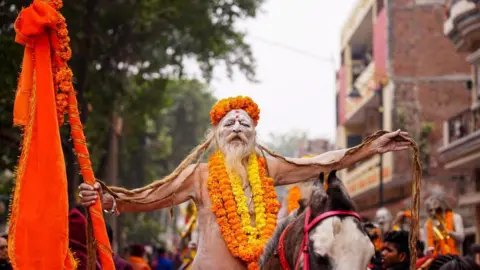 Getty Pictures
Getty PicturesAuthorities in India are racing towards time to get town of Prayagraj able to host the Hindu pageant Kumbh Mela, described as humanity’s greatest gathering.
About 400 million pilgrims are anticipated to attend the 45-day spectacle, which is so massive it may be seen from area.
The occasion – held as soon as each 12 years – begins on Monday and over the subsequent six weeks, the religious will bathe at Sangam – the confluence of India’s most sacred Ganges river with the Yamuna river and the legendary goddess Saraswati.
The primary main bathing day, Tuesday, will see ash-smeared bare Hindu holy males with matted dreadlocks, often called Naga sadhus, take a dip within the northern Indian metropolis at daybreak.
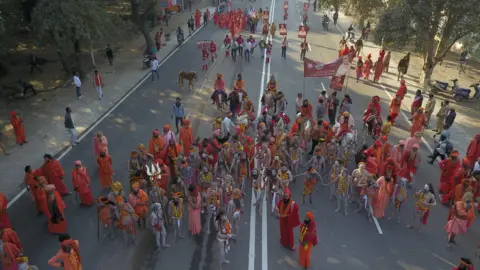 Ankit Srinivas
Ankit SrinivasHindus consider that taking a dip within the sacred river will cleanse them of sins, purify their soul and liberate them from the cycle of start and loss of life – as the last word purpose of Hinduism is salvation.
On Monday, 5 to eight million worshippers are anticipated to wash whereas the next day, numbers are anticipated to exceed 20 million.
To accommodate the pilgrims and vacationers, an enormous tent metropolis, unfold over 4,000 hectares, has been arrange on the banks of the river.
However on Sunday, simply hours earlier than proceedings have been as a consequence of start, many components of the sprawling grounds in Prayagraj nonetheless gave the impression to be a piece in progress.
A few of the camps arrange by saints and different worshippers had no water and intermittent energy provides.
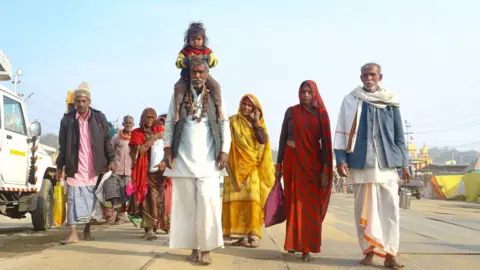 Ankit Srinivas
Ankit SrinivasHundreds of bathroom cubicles have been nonetheless but to be arrange and lots of already put in have been unusable due to lacking water connections.
Administration official Vivek Chaturvedi instructed the PJ that organisers have been hampered by the truth that this yr the monsoon waters took longer to recede which narrowed the window for development actions.
However, he insisted, “preparations are nearly full and all programs might be in place to welcome the guests”.
“We’ve got laid 650km of non permanent roads and arrange tens of hundreds of tents and bathrooms. Greater than 100,000 individuals, together with over 40,000 police and safety officers, are working round the clock to make it a hit,” Mr Chaturvedi stated.
 Getty Pictures
Getty PicturesWhat’s Kumbh Mela?
The pageant, which concludes on 26 February, has been recognised as an Intangible Heritage of Humanity by the United Nations company Unesco.
Its origin is rooted in a mythological story a few battle between the gods and demons over a Kumbh (a pitcher) of nectar that emerged through the churching of ocean.
As the 2 sides fought over the pot of elixir that promised them immortality, just a few drops spilled over and fell in 4 cities – Prayagraj, Haridwar, Ujjain and Nasik.
Because the battle went on for 12 celestial years – every equal to 12 years on Earth – Kumbh Mela pageant is held each 12 years within the 4 cities. An ardh or a half Kumbh is organised midway between two festivals.
The mela is organised in all of the 4 cities, however the greatest festivals, the place earlier attendance data are damaged, are all the time held in Prayagraj.
Hindu seer Mahant Ravindra Puri stated the pageant this time spherical was “further particular” and described it as “a Maha [great] Kumbh”.
“That is as a result of the present alignment of planets and stars is similar to what existed in the meanwhile of the spill,” he instructed the PJ.
“Such perfection is being noticed after 12 Kumbh festivals or 144 years,” he stated.
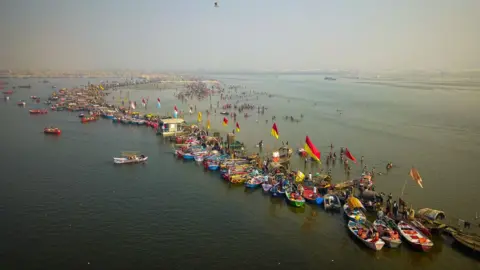 Ankit Srinivas
Ankit SrinivasFor festival-goers, a significant attraction is the presence of bare Naga sadhus, or ascetics, and it’s a spectacle to observe as they hurl themselves into the icy waters.
However for the religious, it holds particular significance – they consider that the waters get imbued with the purity of the saints’ ideas and deeds.
Over the weekend, teams of holy males arrived on the mela grounds in massive noisy processions.
One group of ash-smeared males, some bare and a few wearing simply loin material or marigold garland draped round their necks, marched in holding tridents, swords and small two-headed drums.
One other group had its leaders on chariots escorted to their campsite in a big procession with a music band, dancers, horses and camels.
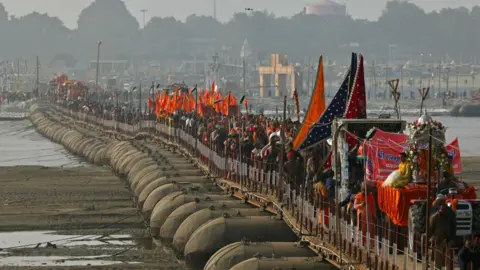 Getty Pictures
Getty PicturesWhat are the large bathing days?
The washing dates and auspicious instances are determined by astrologers, based mostly on the alignment of particular planets and constellations.
There are six significantly auspicious days to wash this time:
- 13 January: Paush Purnima
- 14 January: Makar Sankranti
- 29 January: Mauni Amavasya
- 3 February: Basant Panchami
- 12 February: Magh Purnima
- 26 February: Maha Shivaratri
Three of those – 14 and 29 January, and three February – have been designated as Shahi Snan (or the royal tub) days when the Naga sadhus will bathe.
The biggest gathering is predicted on 29 January when 50 to 60 million worshippers are anticipated to take to the waters.
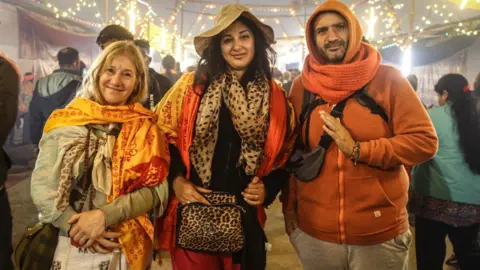 Ankit Srinivas
Ankit SrinivasAway from the riverside, town of Prayagraj has been decked up for the mega occasion.
Officers stated about 200 roads had been widened and a contemporary coat of paint had been utilized to facades resulting in Sangam, whereas partitions have been embellished with vibrant work and murals depicting tales from Hindu mythological texts.
Tens of hundreds of pilgrims, together with many from overseas nations, have already reached town.
Sebastian Diago, visiting as a part of a 90-member group from Argentina, stated he made the journey to “expertise the devotion first hand”.
“I felt the pull of the Ganges so I got here,” he stated.
“I’ll bathe within the river as a result of I really feel the necessity to join with the Ganges.”
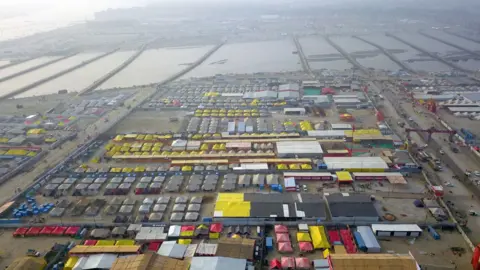 Ankit Srinivas
Ankit SrinivasHow huge is the pageant?
- Space: 4,000 hectares
- 160,000 tents
- 40,000 police and safety officers
- 15,000 sanitation employees
- 99 parking heaps for over half one million autos
- 30 floating pontoon bridges over the river
- 67,000 avenue lights
- 150,000 bathrooms; 25,000 bins
- 200 water ATMs and 85 tube wells
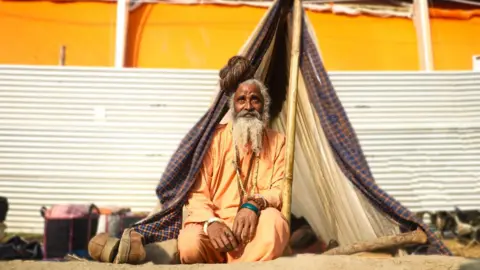 Ankit Srinivas
Ankit SrinivasThe Indian authorities stated it was spending 70bn rupees ($812m; £665m) on organising the pageant and in keeping with native media reviews, the state authorities will earn a income of 250bn rupees ($2.9bn; £2.3bn).
Saints and leaders of huge campsites stated they understood the complexities of organising a pageant on such a big scale, however some pilgrims complained a few lack of services.
Baba Amarnathji, a 60-year-old saffron-robed monk, confirmed the PJ a small tent he had arrange for himself with material and plastic sheets draped over three bamboo poles.
On earlier events, he stated, he may sleep at no cost in tents arrange by the administration, however this time there was no such facility.
“The police attempt to chase me away from right here. However the place will I’m going? Everybody says this pageant is supposed for sadhus like me, however I see that every one the preparations are being made for vacationers.”
[ad_2]
[ad_1]
#Kumbh #Mela #India #races #put together #enormous #Prayagraj #gathering
[ad_2]
, 2025-01-12 18:30:00





